15E: Vector Calculus (Exercises)
( \newcommand{\kernel}{\mathrm{null}\,}\)
1. The domain of vector field
- Answer:
- Vectors
For exercises 2 - 4, determine whether the statement is true or false.
2. Vector field
3. Vector field
- Answer:
- False
4. Vector field
For exercises 5 - 13, describe each vector field by drawing some of its vectors.
5. [T]
- Answer:
-
6. [T]
7. [T]
- Answer:
-
8. [T]
9. [T]
- Answer:
-
10. [T]
11. [T]
- Answer:
-
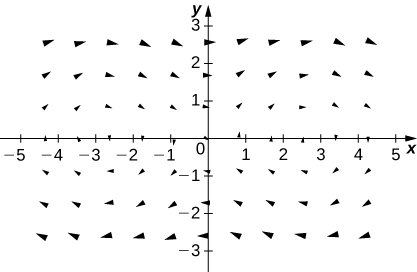
12. [T]
13. [T]
- Answer:
-
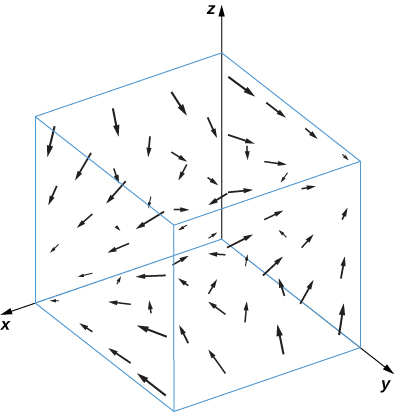
14. [T]
For exercises 15 - 20, find the gradient vector field of each function
15.
- Answer:
16.
17.
- Answer:
18.
19.
- Answer:
20.
21. What is vector field
- Answer:
For exercises 22 - 24, write formulas for the vector fields with the given properties.
22. All vectors are parallel to the
23. All vectors point toward the origin and have constant length.
- Answer:
24. All vectors are of unit length and are perpendicular to the position vector at that point.
25. Give a formula
- Answer:
26. Is vector field
27. Find a formula for vector field
- Answer:
For exercises 28 - 29, assume that an electric field in the
28. Find the components of the electric field in the
29. Show that the electric field at a point in the
- Answer:
A flow line (or streamline) of a vector field
For exercises 30 and 31, show that the given curve
30.
31.
- Answer:
For exercises 32 - 34, let
32.
33.
- Answer:
34.
For exercises 35 - 38, let
35.
- Answer:
- d.
36.
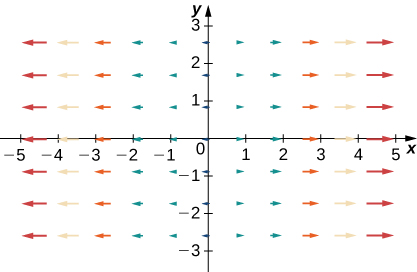
37.
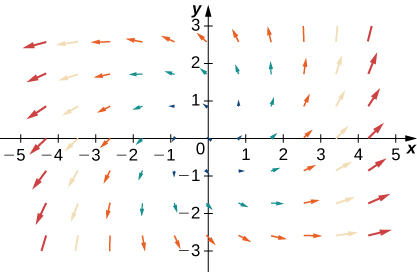
- Answer:
- a.
38.
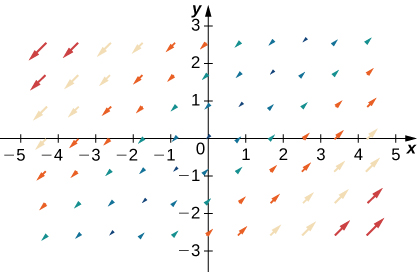
16.2: Line Integrals
1. True or False? Line integral
- Answer:
- True
2. True or False? Vector functions
3. True or False?
- Answer:
- False
4. True or False? A piecewise smooth curve
5. True or False? If
- Answer:
- False
For the following exercises, use a computer algebra system (CAS) to evaluate the line integrals over the indicated path.
6. [T]
7. [T]
- Answer:
8. [T]
9. [T] Evaluate
- Answer:
10. [T] Evaluate
For the following exercises, find the work done.
11. Find the work done by vector field
- Answer:
12. Find the work done by a person weighing 150 lb walking exactly one revolution up a circular, spiral staircase of radius 3 ft if the person rises 10 ft.
13. Find the work done by force field
- Answer:
14. Find the work done by vector field
15. Find the work done by force
- Answer:
16. Find the mass of a wire in the shape of a circle of radius 2 centered at (3, 4) with linear mass density
For the following exercises, evaluate the line integrals.
17. Evaluate
- Answer:
18. Evaluate
19. Evaluate
- Answer:
20. Let
21. [T] Use a computer algebra system to evaluate the line integral
- Answer:
22. [T] Use a computer algebra system to evaluate the line integral
23. [T] Use a CAS to evaluate line integral
- Answer:
24. Evaluate line integral
26. [T] Use a CAS to evaluate
- Answer:
27. [T] Use a CAS to evaluate
In the following exercises, find the work done by force field
28.
- Answer:
29.
<
30.
- Answer:
31. Let
32. Compute the work done by force
- Answer:
33. Evaluate
34. Force
- along the path
- along the straight line joining the initial and final points.
- Is the work the same along the two paths?
- Answer:
- a.
b.
c. Yes
35. Find the work done by vector field
36. How much work is required to move an object in vector field
- Answer:
37. A vector field is given by
38. Evaluate the line integral of scalar function
- Answer:
39. Find
40. Find
- Answer:
For the following exercises, use a CAS to evaluate the given line integrals.
41. [T] Evaluate
42. [T] Evaluate line integral
- Answer:
43. [T] Evaluate the integral
44. [T] Evaluate line integral
- Answer:
45. [T] Evaluate line integral
46. [T] Evaluate
- Answer:
47. Evaluate
48. Find the line integral of
- Answer:
49. Find the line integral of
For the following exercises, find the flux.
50. Compute the flux of
- Answer:
51. Let
52. Let
- Answer:
53. Let
54. Let
- Answer:
Complete the rest of the exercises as stated.
55. Find the line integral of
56. A spring is made of a thin wire twisted into the shape of a circular helix
- Answer:
57. A thin wire is bent into the shape of a semicircle of radius
58. An object moves in force field
- Answer:
59. Find the work done when an object moves in force field
60. If an inverse force field
- Answer:
61. David and Sandra plan to evaluate line integral
16.3: Conservative Vector Fields
1. True or False? If vector field
- Answer:
- True
2. True or False? Function
3. True or False? Vector field
- Answer:
- True
4. True or False? Vector field
5. Justify the Fundamental Theorem of Line Integrals for
- Answer:
6. [T] Find
7. [T] Evaluate line integral
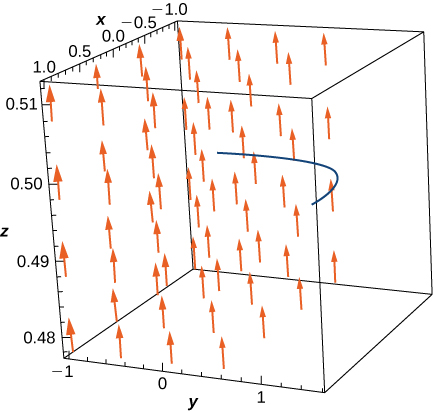
- Answer:
For the following exercises, determine whether the vector field is conservative and, if it is, find the potential function.
8.
9.
- Answer:
- Not conservative
10.
11.
- Answer:
- Conservative,
12.
13.
- Answer:
- Conservative,
For the following exercises, evaluate the line integrals using the Fundamental Theorem of Line Integrals.
14.
15.
- Answer:
16. [T]
17. Find the conservative vector field for the potential function
- Answer:
For the following exercises, determine whether the vector field is conservative and, if so, find a potential function.
18.
19.
- Answer:
20.
21.
- Answer:
22.
23.
- Answer:
24.
25.
- Answer:
For the following exercises, determine whether the given vector field is conservative and find a potential function.
26.
27.
- Answer:
For the following exercises, evaluate the integral using the Fundamental Theorem of Line Integrals.
28. Evaluate
29. [T] Evaluate
- Answer:
30. [T] Evaluate
31. Evaluate
- Answer:
For the following exercises, let
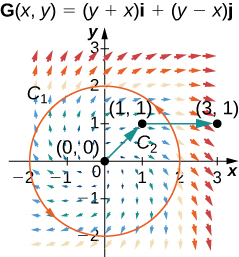
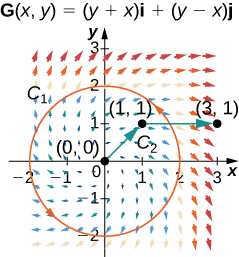
32. Calculate the line integral of
33. Calculate the line integral of
- Answer:
34. Calculate the line integral of
35. Calculate the line integral of
- Answer:
36. [T] Let
37. [T] Find line integral
- Answer:
For the following exercises, show that the following vector fields are conservative by using a computer. Calculate
38.
39.
- Answer:
40. [T]
41. The mass of Earth is approximately
- Answer:
42. [T] Let
43. [T] Let
- Answer:
44. [T] Use a computer algebra system to find the mass of a wire that lies along curve
45. Find the circulation and flux of field
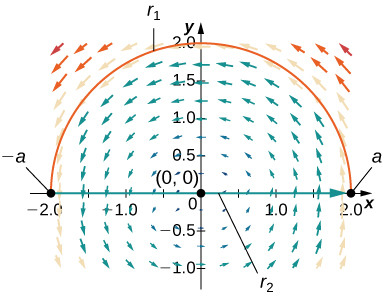
- Answer:
46. Compute
47. Complete the proof of the theorem titled THE PATH INDEPENDENCE TEST FOR CONSERVATIVE FIELDS by showing that
16.4: Green’s Theorem
For the following exercises, evaluate the line integrals by applying Green’s theorem.
1.
2.
- Answer:
3.
4.
- Answer:
5.
6.
- Answer:
For the following exercises, use Green’s theorem.
7. Let
8. Evaluate line integral
- Answer:
9. Find the counterclockwise circulation of field
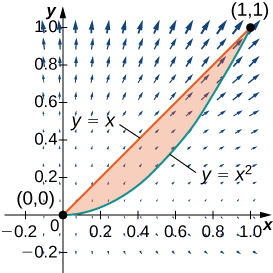
10. Evaluate
- Answer:
11. Evaluate
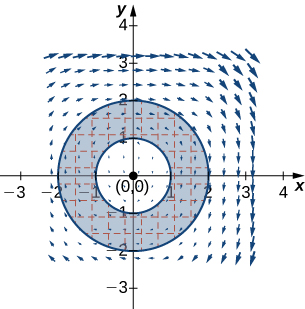
12. Calculate
- Answer:
13. Calculate integral
14. Evaluate integral
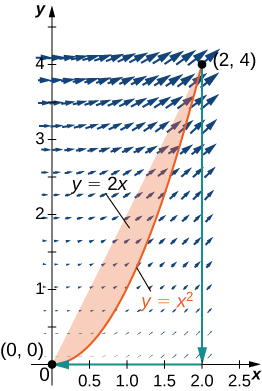
- Answer:
15. Evaluate line integral
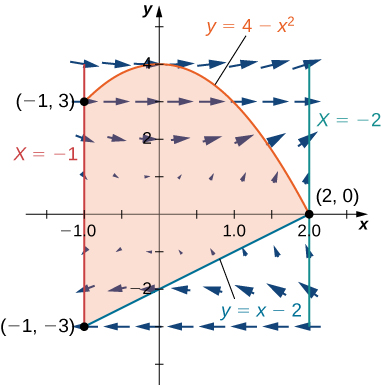
For the following exercises, use Green’s theorem to find the area.
16. Find the area between ellipse
- Answer:
17. Find the area of the region enclosed by parametric equation
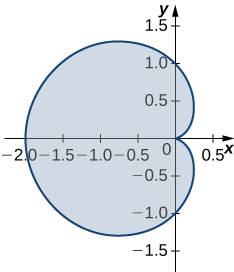
18. Find the area of the region bounded by hypocycloid
- Answer:
19. Find the area of a pentagon with vertices
20. Use Green’s theorem to evaluate
- Answer:
21. Use Green’s theorem to prove the area of a disk with radius
22. Use Green’s theorem to find the area of one loop of a four-leaf rose
- Answer:
23. Use Green’s theorem to find the area under one arch of the cycloid given by the parametric equations:
24. Use Green’s theorem to find the area of the region enclosed by curve
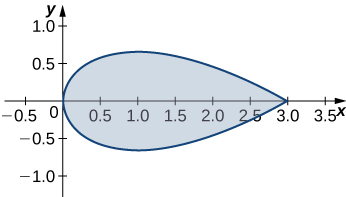
- Answer:
25. [T] Evaluate Green’s theorem using a computer algebra system to evaluate the integral
26. Evaluate
- Answer:
27. Evaluate
28. Evaluate
- Answer:
For the following exercises, use Green’s theorem to calculate the work done by force
29.
30.
- Answer:
31. Evaluate
32. A particle starts at point
- Answer:
33. David and Sandra are skating on a frictionless pond in the wind. David skates on the inside, going along a circle of radius
34. Use Green’s theorem to find the work done by force field
- Answer:
35. Use Green’s theorem to evaluate line integral
36. Evaluate line integral
- Answer:
37. Use Green’s theorem to evaluate line integral
38. Use Green’s theorem to evaluate line integral
- Answer:
39. Use Green’s theorem to evaluate line integral
40. Use Green’s theorem to evaluate line integral
- Answer:
41. Use Green’s theorem to evaluate line integral

42. Let
- Answer:
43. Use Green’s theorem to evaluate line integral
44. Use Green’s theorem to evaluate line integral
- Answer:
45. Use Green’s theorem to evaluate line integral
46. Use Green’s theorem to evaluate
- Answer:
47. Use Green’s theorem to evaluate line integral
48. Let
- Answer:
49. Use Green’s theorem to evaluate line integral
50. Let
- Answer:
51. Use Green’s theorem to evaluate line integral
52. Use Green’s Theorem to evaluate integral
- Answer:
53. Use Green’s theorem in a plane to evaluate line integral
54. Calculate the outward flux of
- Answer:
55. [T] Let
56. Find the flux of field
- Answer:
57. Let
58. [T] Let
- Answer:
59. [T] Find the outward flux of vector field
60. Consider region
- Answer:
16.5: Divergence and Curl
For the following exercises, determine whether the statement is true or false.
If the coordinate functions of
[Hide Solution]
False
All vector fields of the form
If
[Hide Solution]
True
If F is a constant vector field then
If F is a constant vector field then
[Hide Solution]
True
For the following exercises, find the curl of F.
[Hide Solution]
[Hide Solution]
[Hide Solution]
[Hide Solution]
[Hide Solution]
For the following exercises, find the divergence of F.
[Hide Solution]
[Hide Solution]
[Hide Solution]
[ Hide Solution]
[Hide Solution]
For the following exercises, determine whether each of the given scalar functions is harmonic.
[Hide Solution]
Harmonic
If
If
[Hide Solution]
Find
Find the divergence of F for vector field
[Hide Solution]
Find the divergence of F for vector field
For the following exercises, use
Find the
[Hide Solution]
Find the
Find the
[Hide Solution]
Let
For the following exercises, use a computer algebra system to find the curl of the given vector fields.
[T]
[Hide Solution]
[T]
For the following exercises, find the divergence of F at the given point.
[Hide Solution]
[Hide Solution]
For the following exercises, find the curl of F at the given point.
[Hide Solution]
[Hide Solution]
Let
For what value of a is F conservative?
[Hide Solution]
Given vector field
Given vector field
[Hide Solution]
F is conservative.
Find the work done by force field
Compute divergence
[Hide Solution]
Compute
For the following exercises, consider a rigid body that is rotating about the x-axis counterclockwise with constant angular velocity

Express F in terms of i, j, and k vectors.
[Hide Solution]
Find
Find
[Hide Solution]
In the following exercises, suppose that
Does
Does
[Hide Solution]
In the following exercises, suppose a solid object in
Compute the heat flow vector field.
Compute the divergence.
[Hide Solution]
[T] Consider rotational velocity field

Glossary
curl
the curl of vector field
divergence
the divergence of a vector field
16.6: Surface Integrals
For the following exercises, determine whether the statements are true or false.
If surface S is given by
[Hide Solution]
True
If surface S is given by
Surface
[Hide Solution]
True
Given the standard parameterization of a sphere, normal vectors
For the following exercises, find parametric descriptions for the following surfaces.
Plane
[Hide Solution]
Paraboloid
Plane
[Hide Solution]
The frustum of cone
The portion of cylinder

[Hide Solution]
A cone with base radius r and height h, where r and h are positive constants
For the following exercises, use a computer algebra system to approximate the area of the following surfaces using a parametric description of the surface.
[T] Half cylinder
[Hide Solution]
[T] Plane
For the following exercises, let S be the hemisphere
[Hide Solution]
[Hide Solution]
For the following exercises, evaluate
[Hide Solution]

For the following exercises, approximate the mass of the homogeneous lamina that has the shape of given surface S. Round to four decimal places.
[T] S is surface
[Hide Solution]
[T] S is surface
[T] S is surface
[Hide Solution]
Evaluate
Evaluate surface integral
[Hide Solution]
Evaluate

[T] Evaluate

[Hide Solution]
[T] Evaluate where S is the surface defined by
Evaluate
[Hide Solution]
Evaluate
[T] Evaluate

[Hide Solution]
[T] Evaluate

[T] Evaluate

[Hide Solution]
Evaluate
Find the mass of a lamina of density
[Hide Solution]
Compute

Compute
[Hide Solution]
Compute
Compute
[Hide Solution]
For the following exercises, express the surface integral as an iterated double integral by using a projection on S on the yz-plane.
[Hide Solution]
For the following exercises, express the surface integral as an iterated double integral by using a projection on S on the xz-plane
[Hide Solution]
Evaluate surface integral
Evaluate surface integral
[Hide Solution]
Evaluate surface integral
Evaluate surface integral
[Hide Solution]
Evaluate surface integral
Evaluate surface integral
[Hide Solution]
For the following exercises, use geometric reasoning to evaluate the given surface integrals.
[Hide Solution]
A lamina has the shape of a portion of sphere

[Hide Solution]
A lamina has the shape of a portion of sphere

A paper cup has the shape of an inverted right circular cone of height 6 in. and radius of top 3 in. If the cup is full of water weighing
[Hide Solution]
For the following exercises, the heat flow vector field for conducting objects i
[Hide Solution]
For the following exercises, consider the radial fields

Find the total flux across S with
Show that for
[Hide Solution]
The net flux is zero.
16.7: Stokes’ Theorem
For the following exercises, without using Stokes’ theorem, calculate directly both the flux of
[Hide Solution]
[Hide Solution]
[Hide Solution]
For the following exercises, use Stokes’ theorem to evaluate
Use Stokes’ theorem to evaluate

[Hide Solution]
[T] Use a computer algebraic system (CAS) and Stokes’ theorem to approximate line integral
[T] Use a CAS and Stokes’ theorem to approximate line integral
[Hide Solution]
[T] Use a CAS and Stokes’ theorem to approximate line integral
Use Stokes’ theorem to evaluate
[Hide Solution]
[T] Use a CAS and Stokes’ theorem to evaluate
[T] Use a CAS and Stokes’ theorem to evaluate
[Hide Solution]
[T] Use a CAS and Stokes’ theorem to evaluate
Use Stokes’ theorem to evaluate
[Hide Solution]
Use Stokes’ theorem to evaluate line integral
Use Stokes’ theorem to evaluate

[Hide Solution]
Use Stokes’ theorem to evaluate
Use Stokes’ theorem for vector field
[Hide Solution]
\[\iint_S (curl \, F \cdot N)dS = -3\pi]
Use Stokes’ theorem for vector field
A certain closed path C in plane
[Hide Solution]
Use Stokes’ theorem and let C be the boundary of surface
Let S be hemisphere
[Hide Solution]
Let
Use Stokes’ theorem to evaluate
[Hide Solution]
Use the surface integral in Stokes’ theorem to calculate the circulation of field F,

Use Stokes’ theorem to compute

[Hide Solution]
Use Stokes’ theorem to evaluate
Let
[Hide Solution]
[T] Use a CAS and let
Let S be ellipsoid
[Hide Solution]
Let S be the part of paraboloid
[T] Use a CAS and Stokes’ theorem to evaluate
[Hide Solution]
[T] Use a CAS and Stokes’ theorem to evaluate
[T] Use a CAS to evaluate
[Hide Solution]
Let S be paraboloid
For the following application exercises, the goal is to evaluate
Evaluate a surface integral over a more convenient surface to find the value of A.
[Hide Solution]
Evaluate A using a line integral.
Take paraboloid

[Hide Solution]
For the following exercises, let S be the disk enclosed by curve
What is the length of C in terms of
What is the circulation of C of vector field
[Hide Solution]
For what value of
Circle C in plane
[Hide Solution]
Velocity field
Evaluate integral
[Hide Solution]
For the following exercises, use Stokes’ theorem to find the circulation of the following vector fields around any smooth, simple closed curve C.
[Hide Solution]
0
Contributors
Gilbert Strang (MIT) and Edwin “Jed” Herman (Harvey Mudd) with many contributing authors. This content by OpenStax is licensed with a CC-BY-SA-NC 4.0 license. Download for free at http://cnx.org.


